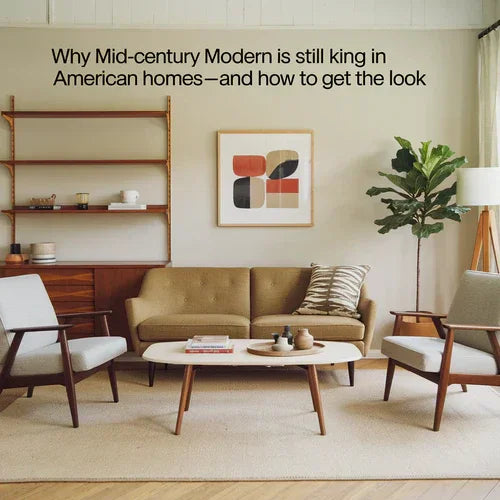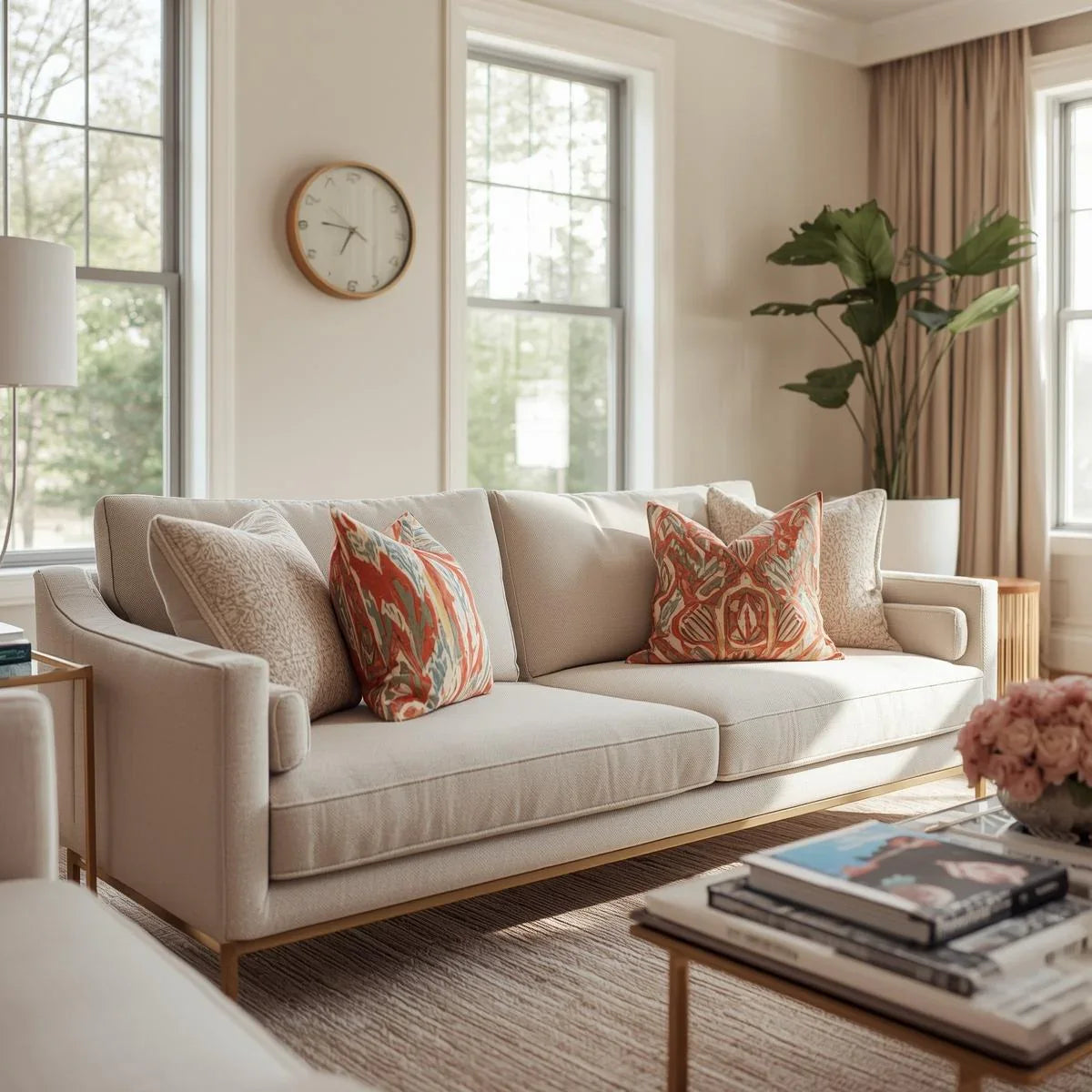Nowadays people continue celebrating Mid-Century Modern (MCM) design not just for any reason but with good reason. In the past few decades, this style has become one of the most frequently chosen ones in American houses, as it gives a touch of elegance and comfort at the same time. Housing in 2025 stays modern and streamlined, it brings the company’s design aesthetic back to functionality while still maintaining that attractive look. Yet what sets MCM apart from its contemporaries, and how can one incorporate this element into their interior? Now it is time to examine how Mid-Century Modern has retained its title as the reigning ruler of American interiors and points to consider when blending it into your home with ease.
The Features of Mid-century Modern Home Design
Originating in the period of the 1940s and prevalent up to the 1960s, Mid-Century Modernist design was associated with diminutive references to post-war architectural structure and requirements for utility, basic, as well as well-designed objects.
Sociologically, MCM can be summed up in three concepts: simplicity, reductionism, and practicality. This furniture enjoys angular and geometric forms, a low level of formalism, and, above all, an emphasis on rationality. The said elements remain relevant even to this generation of homemakers who prefer some Classic Touches to their house’s structural design.

Hence, the essence of Mid-Century Modern is that this style is not subordinated to trends. Unlike the other trends that appear and disappear in a short time, MCM has a unique characteristic of versatility of being used in different apartments ranging from urban to suburban houses. It’s simple and, therefore, suitable for any room as it has organic forms and natural textures.
Mid-Century Modern has evolved to mean not just design but a design philosophy that people adopt willingly. Indeed, it honors functionality in such a way while not shying away from being a striking, sleek design on its own and featuring its ingenious furniture,” says Emily Henderson, an acclaimed interior designer (April 2025).
Basic Characteristics of Mid-Century Modern Style
To achieve a true Mid-Century Modern look, focus on these signature elements:

1. Clean Lines and Minimalism: Concerning the design of MCM furniture, Mercedes Benz furniture is characterized by simple and minimalistic designs. Unlike some modern architectural styles, it eschews fancy trims and flashy and Geeked practicality without compromising aesthetics. For instance, a Mid-Century Modern sofa is likely to have wooden legs, an exposed frame, and a very low profile along with sleek cushions in low to neutral tones. Emphasis should be placed on using additional modern but practical home accessories such as throw cushions or quilts in plain colors or geometric types will serve as an added assurance.
2. Natural Materials and Organic Shapes: Chic, relaxed MCM interiors nod to nature with wood, leather, and glass making up the majority of the furniture pieces. Furniture should also be contrasted with muted warm wood tones, beech teak or walnut for example help to stabilize a room. If you want to incorporate this look into your house, it is suggested to put wooden lampshades, organic fabric pillows, and a natural fiber rug or blanket.
3. Bold, Graphic Patterns: Although the design landscape of MCM is general, it is not immune to an opulent graphic image. Consider geometric patterned fabric for covering pillows or the use of retro-style fabrics for making quilts or curtains in sharply contrasting colors. Such patterns can be rather easily introduced by such textiles as curtains, throw cushions, or blankets.
4. Functional Furniture: At MCM it simply means making good use of the space that is available to you. That’s why the furniture is functional and the items are created for real-life usage, for example, a plain couch with hidden compartments or an unpretentious coffee table. Objects such as Roman shades are ideal for giving that style those straight-line feelings that make it dominant and perfect in its functionality.
Guides to Adding Mid-Century Modern Design to Your Home
We’ve established the basics of Mid-Century Modern design, so now go forth with a little guidance on how to get this look in your space, small, large, square, or vintage. Here are some key tips to help you get the MCM aesthetic:
1. Start with Furniture: Buy classics of the design, like an Eames chair Danish credenza, or a sleek sofa that you admire and dream about. Wainscot with solid wood finishes with out-of-box designs and avoid glossy sheens; a variety of wood shades are preferable.
2. Accessorize with Textiles: Blanket everything in softness and functionality was the look that reigned during that time. Luxury decorative cushions and throw cushions here provide comfort and elegance of the interior. The geometric patterns or solids for your quilts also look perfect in the bedroom while sleek curtains and Roman shades lend elegance to your window dressing.
3. Lighting Is Key: This has ensured that lighting remains one of the most critical aspects that can either make or unmake a Mid-Century Modern room. Search for pendant lamps, sputnik chandeliers, and high, plain-looking table lamps. Metal or glass lampshades and furnishing also contribute to MCM feel clean-lined industrial adorned with wooden accents.
4. Add Some Retro Flair: Finally, you’ll want to have some minor 80s additions – records or clocks can be mostly of these, modernism including some sort of paintings or photographs. This simple solution can convert such space, yet retain the aptness of the Mid-Century aesthetic in the grasp of both form as well as substance.
There is, therefore, much more to Mid-Century Modern than furniture; it is a lifestyle. Another class of textiles that can be used to create beauty in a room includes throw cushions, blankets, and pillows that turn a room into an efficient timeless space. This is such a cool tradition to create your home comfortable and fashionable at the same time,” responded Jonathan Adler, the renowned designer, in March 2025.
Why It Works in 2025
Mid-Century Modern is still going strong in 2025, so why is that so? The answer therefore lies in versatility and due to the timeless appearance that is associated with it. As sustainability is today more important than ever, more and more consumers seek quality and that is exactly what Mid-Century Modern offers – well-crafted and solid furniture. Also, its sleek and practical appearance looks fantastic in contemporary and classic interiors and is the ideal solution for people who want a beautiful yet comfortable home.
As sizes and embellishments grow bigger in contemporary society, Mid-Century Modern has an inherent timely quality that fulfills a modern need. No matter if you're utilizing a retro sofa in the living room or the Mid-Century Modern pillows and blankets in the bedrooms; this design trend is yet a relevant part of the American home design.
Conclusion
The reason why Mid-Century Modern remains a favorite among Americans is because it has a hundred percent aesthetics and a hundred percent usability. Due to its neat lines, natural curves, and incorporated furniture, it is still modern today, and due to its flexibility, it will be modern in 2025. It doesn’t matter if you add beautiful Mid-Century Modern lamps or put aesthetic throw pillows and quilts on your bed – getting Mid-Century Modern into your house will make it a beautiful forever home.
Before you begin your Mid-Century Modern quest, understand this style is not just furniture, but it is living in a style that is timeless, efficient, and suitable for your personality. Begin with throw cushions or a flamboyant lamp, and before you know it, you have an entire room that’s faithfully older but au courant.
‘Mid-Century Modern still goes through the huddle because it is not just a concept but an emotion which people feel, concerned with privacy, minimalism and elegance’. – Emily Henderson, April 2025.
FAQ’s
1. Why is Mid-Century Modern still popular in American homes today?
MCM is still popular in the United States today due to the options of simple, aesthetically pleasing, usable, and organic forms. This implies spare and functional as a design concept which is fitting for today’s homeowners who cannot afford to pay a premium for form while sacrificing on function. Also, its simplicity enables MCM to be grated into other design modes, and therefore it is classic and timeless. It also convinces perfectly today’s valuable and responsible approach to sustainable and durable materials.
2. How can I incorporate Mid-Century Modern design into my home?
Bringing the principles of Mid-Century Modern aesthetic to your home begins with furniture that exhibits clean lines and geometrical forms and materials like wood, leather, and metal. Choose simple elegant styles including low sofas, simple coffee tables, and large lamps. Pair these with throw pillows with drastic patterns, geometric quilts, throw cushions, or Roman shades for more texture. Lighting is also important—the purpose of old-style lamps and chandeliers for the finery.
3. What are the key elements of Mid-Century Modern decor?
There are certain characteristics called Mid-Century Modern, which include clean lines, geometric shapes, and simple functional designs. The furniture mostly is designed to be close to the ground with wooden legs; could be teak or walnut. Organic forms and clear lines of geometric patterns are also typical for the Interiors through the use of throw cushions, pillows, and quilts. Secondly, the materials used in MCM design are natural, especially wood and glass, and also effective statement lighting and clean and clear lines without many accessories.
4. Is Mid-Century Modern suitable for all types of homes?
Yes! Mid Century Modern could easily be used in any kind of house including modern apartments, suburban houses, and even loft. The descriptive style makes it relatively easy to fit into different sizes and types of rooms you may have in your house. The straight lines and elegant appearance of MCM furniture will fit easily in the more traditional as well as the more modern homes due to their flexibility of design and usage which homeowners will prize as timeless pieces of furniture.



